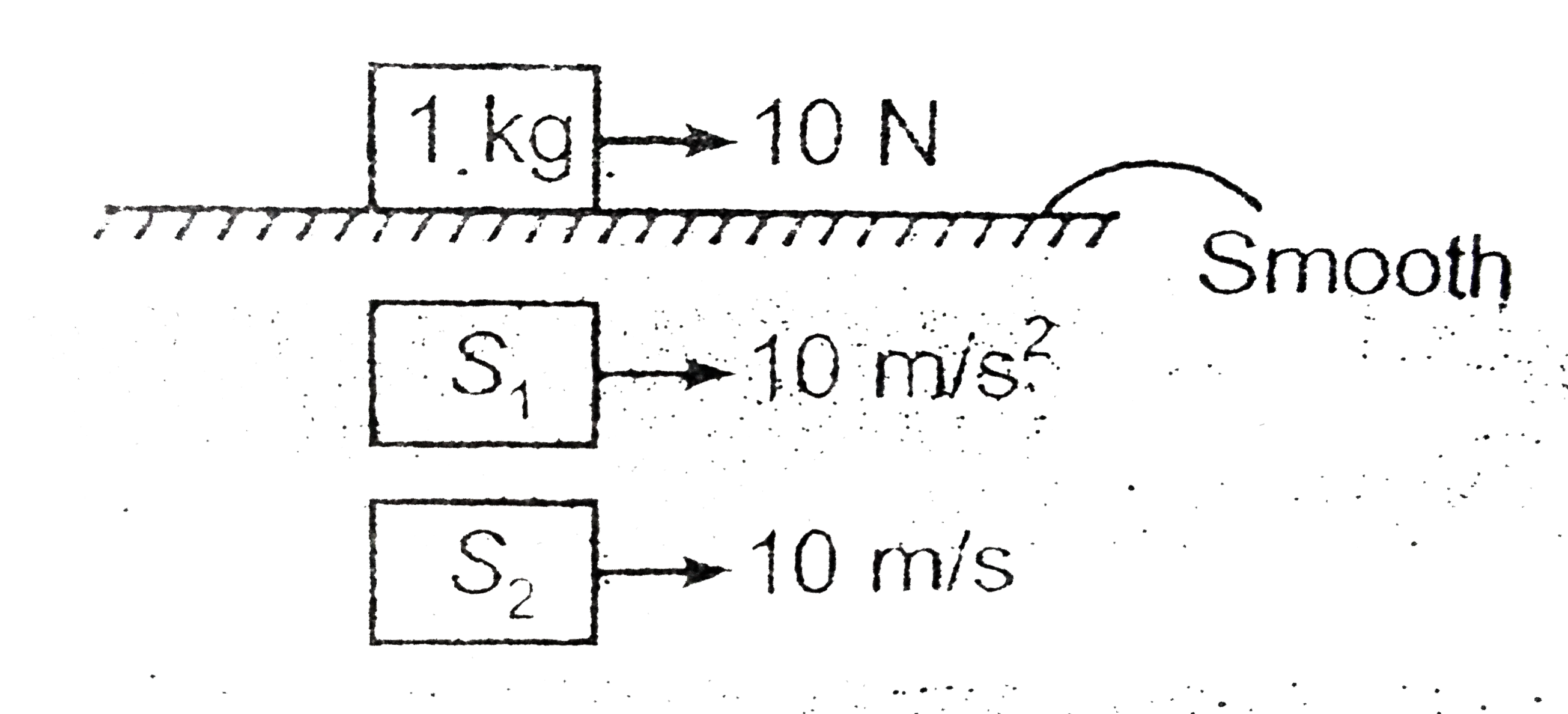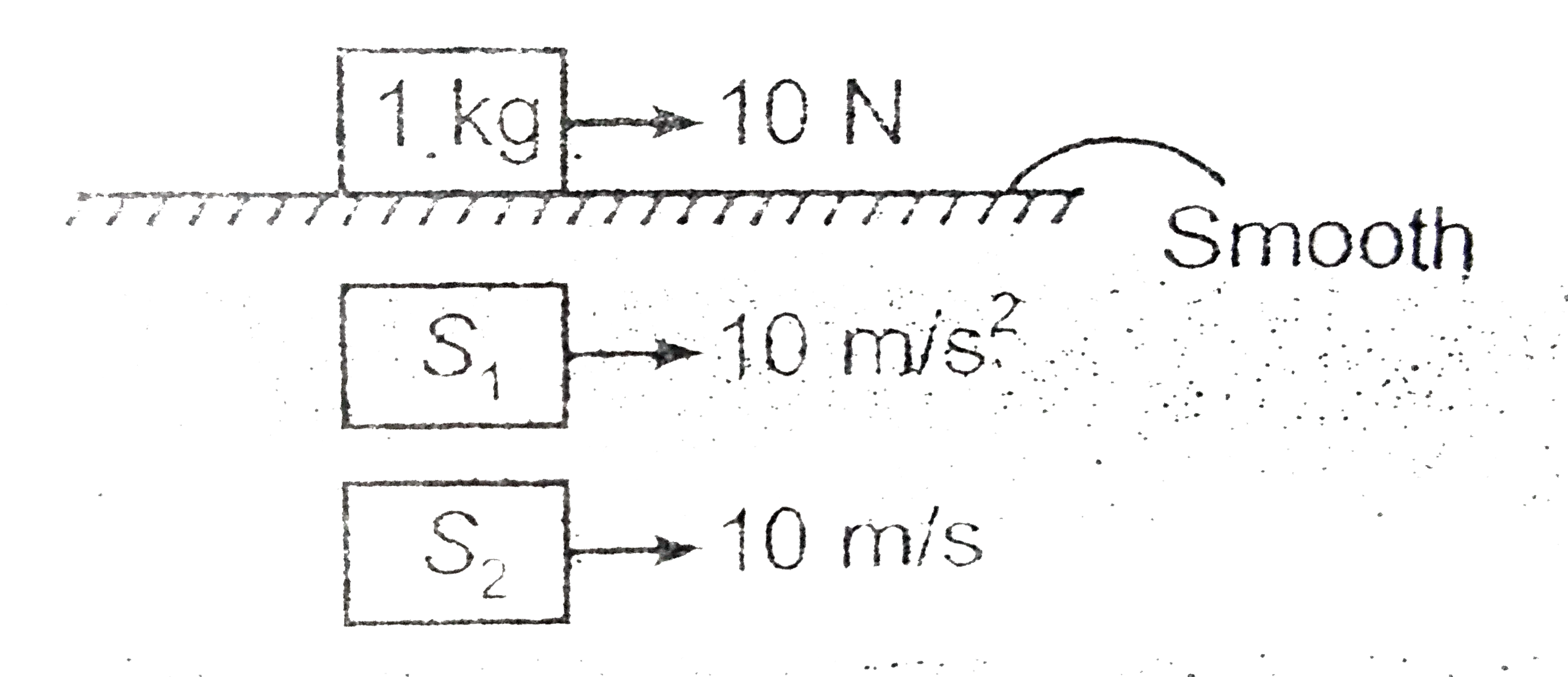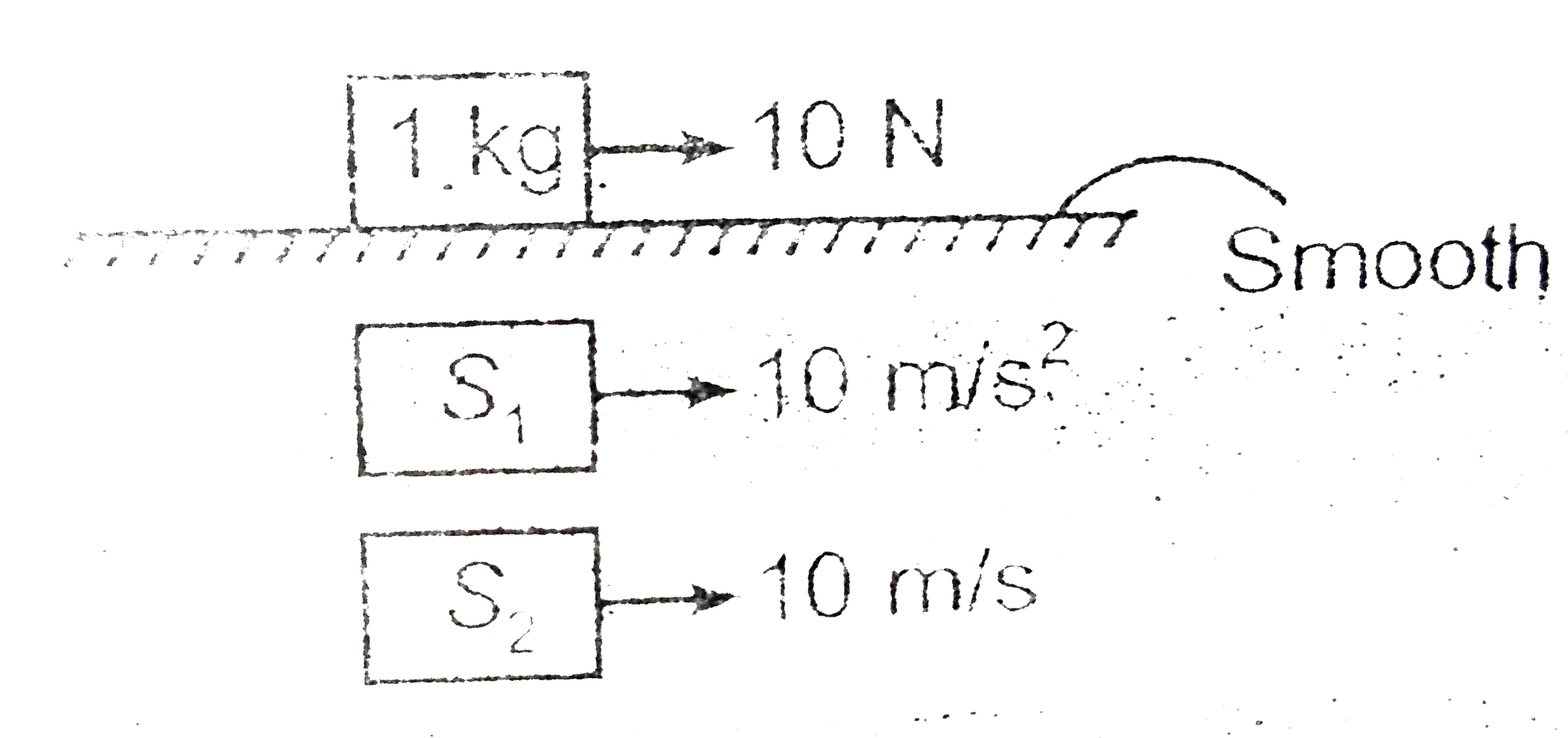A particle is observed from two frames S1andS2. The frame S2 moves with respect to S1 with an acceleration a. Let F1andF2 be the pseudo forces on the particle when seen from S1andS2 respectively. Which of the following are not possible ?
F1≠0,F2=0
F1≠0,F2≠0
F1=0,F2≠0
F1=0,F2=0
The correct Answer is:d
To solve the problem, we need to analyze the situation involving two reference frames, S1 and S2, where S2 is accelerating with respect to S1. We will identify the pseudo-forces acting on a particle observed from both frames and determine which scenario is not possible.
1. Understanding the Frames:
- Let S1 be an inertial frame (not accelerating).
- Let S2 be a non-inertial frame that is accelerating with respect to S1 with an acceleration a.
2. Identifying the Pseudo-Forces:
- In an inertial frame like S1, the particle experiences no pseudo-force, so F1=0.
- In the non-inertial frame S2, a pseudo-force F2 acts on the particle due to the acceleration of the frame. The pseudo-force is equal to −ma, where m is the mass of the particle.
3. Case Analysis:
- Case 1: If S1 is at rest and S2 is accelerating, then:
- F1=0 (since S1 is inertial).
- F2≠0 (since S2 is non-inertial).
- Case 2: If S2 is at rest and S1 is accelerating, then:
- F1≠0 (since S1 is non-inertial).
- F2=0 (since S2 is inertial).
- Case 3: If both frames are accelerating with respect to each other, then:
- Both F1 and F2 will be non-zero.
- Case 4: If both frames are at rest relative to each other, then both F1 and F2 can be zero.
4. Identifying the Impossible Scenario:
- The question asks which scenario is not possible.
- If F1=0 (meaning S1 is inertial) and F2=0 (meaning S2 is also inertial), this means both frames cannot be accelerating relative to each other. This contradicts the condition that S2 is accelerating with respect to S1.
- Therefore, the scenario where both F1 and F2 are zero is not possible.
Conclusion:
The scenario where both pseudo-forces F1 and F2 are zero is not possible.
- Let S1 be an inertial frame (not accelerating).
- Let S2 be a non-inertial frame that is accelerating with respect to S1 with an acceleration a.
- In an inertial frame like S1, the particle experiences no pseudo-force, so F1=0.
- In the non-inertial frame S2, a pseudo-force F2 acts on the particle due to the acceleration of the frame. The pseudo-force is equal to −ma, where m is the mass of the particle.
- Case 1: If S1 is at rest and S2 is accelerating, then:
- F1=0 (since S1 is inertial).
- F2≠0 (since S2 is non-inertial).
- Case 2: If S2 is at rest and S1 is accelerating, then:
- F1≠0 (since S1 is non-inertial).
- F2=0 (since S2 is inertial).
- Case 3: If both frames are accelerating with respect to each other, then:
- Both F1 and F2 will be non-zero.
- Case 4: If both frames are at rest relative to each other, then both F1 and F2 can be zero.
- The question asks which scenario is not possible.
- If F1=0 (meaning S1 is inertial) and F2=0 (meaning S2 is also inertial), this means both frames cannot be accelerating relative to each other. This contradicts the condition that S2 is accelerating with respect to S1.
- Therefore, the scenario where both F1 and F2 are zero is not possible.
The scenario where both pseudo-forces F1 and F2 are zero is not possible.
Topper's Solved these Questions
- BOOK - ANURAG MISHRACHAPTER - FORCE ANALYSISEXERCISE - Level-349videos
FORCE ANALYSIS
- BOOK - ANURAG MISHRACHAPTER - FORCE ANALYSISEXERCISE - Matching type13videos
FORCE ANALYSIS
- BOOK - ANURAG MISHRACHAPTER - FORCE ANALYSISEXERCISE - level 1103videos
FORCE ANALYSIS
- BOOK - ANURAG MISHRACHAPTER - DESCRIPTION OF MOTIONEXERCISE - Level-334videos
DESCRIPTION OF MOTION
- BOOK - ANURAG MISHRACHAPTER - IMPULSE AND MOMENTUMEXERCISE - matching3videos
IMPULSE AND MOMENTUM
Similar Questions
A constatnt force of 10 N act on a block as shown in figure intal velocity of the particle is zero. It is observed from three frames of reference S1,S2 and ground. The frame S1 start from rest and move with constnat acceleration 10m/s. The frames S1andS2 and particle start moving simultaneously at t=0.

Work done on block in 1 s as observed from frame S1 isView SolutionA constatnt force of 10 N act on a block as shown in figure intal velocity of the particle is zero. It is observed from three frames of reference S1,S2 and ground. The frame S1 start from rest and move with constnat acceleration 10m/s. The frames S1andS2 and particle start moving simultaneously at t=0.

Net work done on block in 1 s as observed from frame S2 isView Solution
Knowledge Check
- Question 1 - Select One
Two frame S1 and S2 are non-inertial. Then frame S2 when observed from S1 is inertial.
A frame in motion is not necessarily a non-inertial frameAIf both Accertion and Reason are true and the reason is correct explanation of the Assertion.BIf both Assertion and Reason are true but reason is not the correct explanation of Assertion.CIf Assertion is true, but the Reason is false.DIf Assertion is false but the Reason is true. - Question 2 - Select One
Two SHMs s1=asinωt and s2=bsinωt are superimposed on a particle. The s1 and s2 are along the direction which makes 37∘ to each other
Athe particle will perform SHMBthe path of particle is straight lineCBoth (a) and (b) are correctDBoth (a) and (b) are wrong - Question 3 - Select One
The oxidation number of S in S8,S2F2, and H2S, respectively, are
A−2,+1and−2B−2,−1and+2C0, +1 and +2D0, +1 and -2
A constatnt force of 10 N act on a block as shown in figure intal velocity of the particle is zero. It is observed from three frames of reference S1,S2 and ground. The frame S1 start from rest and move with constnat acceleration 10m/s. The frames S1andS2 and particle start moving simultaneously at t=0.

The rate at which work is done by constant force on the particle is always non-negative when observed fomView SolutionA particle is found to be at rest when seen from a frame S1 and moving with a constant velocity when seen from another frame S2. Select the possible options :
View SolutionThe accleration of a particle as seen from two frames S1 and S2 have equal magnitudes 4 m/s2
View SolutionAcceleration of a particle as seen from two reference frames 1 and 2 has magnitude 3m/s2 and 4m/s2 respectively. What can be magnitude of acceleration of frame 2 with respect to frame 1?
View SolutionThe oxidation number of sulphur in S8,S2F2andH2S respectively are:
View Solution

